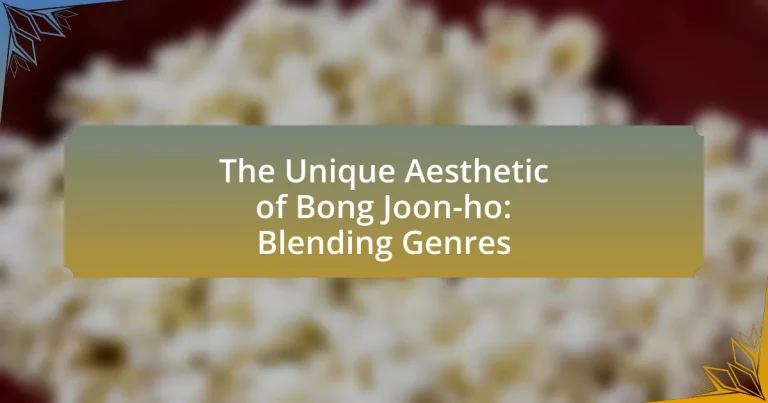Bong Joon-ho is a renowned filmmaker recognized for his unique aesthetic characterized by the blending of genres such as thriller, drama, horror, and dark comedy. His films, including “Parasite,” “Snowpiercer,” and “The Host,” showcase complex narratives that explore social issues through meticulous visual storytelling and character development. This article examines how Bong Joon-ho’s genre-blending techniques enhance storytelling, the thematic elements that define his style, and the critical reception of his work, highlighting the impact of his cultural background on his cinematic approach. Additionally, it offers insights for filmmakers on achieving a similar aesthetic and maintaining audience engagement while blending genres.

What defines the unique aesthetic of Bong Joon-ho?
Bong Joon-ho’s unique aesthetic is defined by his masterful blending of genres, combining elements of thriller, drama, and dark comedy to create complex narratives. His films often explore social issues, utilizing a meticulous visual style that includes striking cinematography and detailed production design. For instance, in “Parasite,” the juxtaposition of the wealthy and the poor is visually represented through contrasting settings and color palettes, enhancing the film’s thematic depth. Additionally, Bong’s use of satire and irony serves to critique societal norms, making his storytelling both engaging and thought-provoking.
How does Bong Joon-ho blend genres in his films?
Bong Joon-ho blends genres in his films by seamlessly integrating elements of drama, horror, comedy, and thriller, creating a unique narrative experience. For instance, in “Parasite,” he combines social commentary with dark humor and suspense, effectively engaging audiences while addressing class disparities. His ability to shift tones within a single film allows for unexpected emotional depth and complexity, as seen in “Snowpiercer,” where action and dystopian themes coexist with poignant character studies. This genre-blending technique not only enhances storytelling but also challenges conventional cinematic boundaries, making his work distinctive and critically acclaimed.
What are the primary genres Bong Joon-ho incorporates?
Bong Joon-ho primarily incorporates genres such as thriller, drama, horror, and science fiction in his films. His unique storytelling blends these genres to create complex narratives that often explore social themes and human emotions. For instance, “Parasite” combines elements of dark comedy and thriller, while “Snowpiercer” merges science fiction with social commentary, showcasing his ability to intertwine various genres effectively.
How does genre blending enhance storytelling in his works?
Genre blending enhances storytelling in Bong Joon-ho’s works by creating complex narratives that engage audiences on multiple emotional and intellectual levels. This technique allows him to combine elements from various genres, such as horror, drama, and comedy, which results in unpredictable plot developments and rich character arcs. For instance, in “Parasite,” the seamless integration of thriller and social commentary not only heightens tension but also deepens the critique of class disparity, making the story more impactful. By merging genres, Bong Joon-ho effectively challenges conventional storytelling norms, inviting viewers to experience a multifaceted exploration of themes and emotions.
Why is Bong Joon-ho’s aesthetic considered unique?
Bong Joon-ho’s aesthetic is considered unique due to his masterful blending of genres, which creates a distinctive narrative style that defies conventional categorization. His films often combine elements of thriller, drama, horror, and dark comedy, allowing for complex storytelling that engages audiences on multiple levels. For instance, “Parasite” seamlessly merges social commentary with suspense and humor, earning the film the Academy Award for Best Picture in 2020, a historic achievement for a non-English language film. This genre fusion, along with his meticulous attention to visual detail and character development, sets Bong Joon-ho apart in contemporary cinema.
What visual and thematic elements contribute to his style?
Bong Joon-ho’s style is characterized by a blend of visual and thematic elements that include meticulous composition, contrasting color palettes, and social commentary. His films often feature symmetrical framing and dynamic camera movements, which enhance the narrative tension and emotional depth. Thematic elements such as class struggle, environmental issues, and human relationships are prevalent, providing a critical lens through which audiences can examine societal norms. For instance, in “Parasite,” the stark contrast between the opulence of the wealthy and the struggles of the poor is visually represented through the use of space and architecture, reinforcing the film’s critique of social inequality. This combination of visual precision and thematic depth solidifies Bong Joon-ho’s unique aesthetic in cinema.
How does his cultural background influence his aesthetic choices?
Bong Joon-ho’s cultural background significantly influences his aesthetic choices by integrating elements of South Korean history, societal issues, and traditional storytelling into his films. His upbringing in South Korea, a nation with a complex history of colonialism and rapid modernization, shapes his narrative style and visual aesthetics, often reflecting themes of class struggle and social inequality. For instance, in “Parasite,” the stark contrast between the wealthy and the poor is depicted through meticulous set design and cinematography, showcasing his ability to blend genres while commenting on contemporary societal issues. This cultural context not only informs his thematic choices but also enhances the emotional resonance of his work, making it relatable to both local and global audiences.
What are the key films that showcase Bong Joon-ho’s genre blending?
Bong Joon-ho’s key films that showcase his genre blending include “Parasite,” “Snowpiercer,” and “The Host.” “Parasite” uniquely combines elements of thriller, drama, and dark comedy, winning the Academy Award for Best Picture in 2020, which highlights its critical acclaim and genre-defying narrative. “Snowpiercer” merges science fiction with action and social commentary, illustrating class struggle aboard a train in a post-apocalyptic world. “The Host” blends horror, drama, and comedy, focusing on a family’s struggle against a monstrous creature while addressing environmental issues. Each of these films exemplifies Bong Joon-ho’s ability to fuse genres, creating compelling and multifaceted storytelling.
How do specific films exemplify his unique aesthetic?
Bong Joon-ho’s films exemplify his unique aesthetic through their masterful blending of genres, intricate storytelling, and social commentary. For instance, “Parasite” seamlessly combines elements of thriller, drama, and dark comedy, showcasing class disparity while maintaining suspense and humor. The film’s use of visual metaphors, such as the contrasting settings of the wealthy Park family’s home and the impoverished Kim family’s basement, reinforces its thematic depth. Similarly, “Snowpiercer” merges science fiction with action and social critique, using a dystopian train as a microcosm for class struggle, effectively illustrating the consequences of capitalism. These films demonstrate Bong’s ability to engage audiences emotionally while provoking critical thought, solidifying his distinctive cinematic style.
What role does humor play in his dramatic narratives?
Humor serves as a critical device in Bong Joon-ho’s dramatic narratives, providing relief and depth to intense situations. By integrating humor, Bong Joon-ho enhances character development and engages the audience, allowing them to connect emotionally while navigating complex themes. For instance, in “Parasite,” moments of dark humor juxtapose the film’s social commentary, making the critique of class disparity more impactful. This blend of humor and drama not only entertains but also prompts reflection on serious societal issues, demonstrating the effectiveness of humor in enriching narrative complexity.
How does social commentary manifest in his genre-blending films?
Social commentary in Bong Joon-ho’s genre-blending films manifests through the juxtaposition of social issues with various cinematic styles, allowing for a multifaceted exploration of themes such as class disparity, environmental concerns, and systemic injustice. For instance, in “Parasite,” the blending of thriller and dark comedy highlights the stark contrast between the wealthy and the impoverished, effectively critiquing capitalism and social stratification. This film’s narrative structure and visual storytelling serve to engage audiences while prompting reflection on societal norms, as evidenced by its global acclaim and recognition, including winning the Academy Award for Best Picture in 2020.
What critical reception have his films received regarding their aesthetic?
Bong Joon-ho’s films have received widespread acclaim for their unique aesthetic, characterized by a blend of genres and visual storytelling. Critics often highlight his ability to seamlessly combine elements of horror, drama, and dark comedy, creating a distinctive cinematic experience. For instance, “Parasite” was praised for its meticulous production design and visual metaphors, which contributed to its commentary on class disparity. The film won the Palme d’Or at the Cannes Film Festival and received multiple Academy Awards, underscoring its critical success. Additionally, Bong’s use of color and composition has been noted as integral to his storytelling, with reviewers frequently citing his films as visually striking and thematically rich.
How have audiences responded to his blending of genres?
Audiences have responded positively to Bong Joon-ho’s blending of genres, appreciating his ability to seamlessly integrate elements of thriller, drama, and dark comedy. This unique approach has garnered critical acclaim, as evidenced by his films like “Parasite,” which won the Academy Award for Best Picture in 2020, highlighting the audience’s recognition of his innovative storytelling. Additionally, box office success and audience ratings on platforms such as Rotten Tomatoes reflect a strong appreciation for his genre-blending style, indicating that viewers are engaged and intrigued by his unconventional narratives.
What awards have his films garnered that highlight their uniqueness?
Bong Joon-ho’s films have garnered numerous prestigious awards that highlight their uniqueness, including the Academy Award for Best Picture for “Parasite,” which made history as the first non-English language film to win this honor. Additionally, “Parasite” received the Palme d’Or at the Cannes Film Festival, showcasing its exceptional storytelling and genre-blending capabilities. His film “Snowpiercer” won the Best Film award at the 2014 Sydney Film Festival, further emphasizing his innovative approach to narrative and visual style. These accolades reflect the distinctiveness of his work in the cinematic landscape.
How can filmmakers learn from Bong Joon-ho’s approach to genre blending?
Filmmakers can learn from Bong Joon-ho’s approach to genre blending by embracing the seamless integration of diverse genres to enhance storytelling. Bong Joon-ho effectively combines elements of horror, drama, and comedy, as seen in films like “Parasite,” which won the Academy Award for Best Picture in 2020. This blending creates a rich narrative texture that engages audiences on multiple emotional levels. By studying his techniques, filmmakers can understand how to use genre conventions to subvert expectations and deepen thematic exploration, ultimately crafting more compelling and innovative cinematic experiences.
What techniques can be applied to achieve a similar aesthetic?
To achieve a similar aesthetic to Bong Joon-ho’s unique style of blending genres, filmmakers can employ techniques such as genre hybridity, visual storytelling, and character complexity. Genre hybridity involves combining elements from different genres, which allows for unexpected narrative developments and emotional depth, as seen in Bong Joon-ho’s films like “Parasite,” where dark comedy intersects with social commentary. Visual storytelling can be enhanced through meticulous framing, color palettes, and symbolic imagery, creating a rich visual language that conveys themes without relying solely on dialogue. Additionally, character complexity is crucial; developing multi-dimensional characters who embody conflicting traits fosters audience engagement and reflects the nuanced realities of human experience, a hallmark of Bong Joon-ho’s work. These techniques collectively contribute to a distinctive aesthetic that resonates with viewers on multiple levels.
How can filmmakers effectively combine genres without losing coherence?
Filmmakers can effectively combine genres without losing coherence by establishing a clear thematic foundation that unifies the different elements. This approach allows for a seamless integration of diverse genres, as seen in Bong Joon-ho’s films, where he often intertwines social commentary with suspense and humor. By maintaining a consistent tone and character development that resonates across genres, filmmakers can create a cohesive narrative. For instance, in “Parasite,” the blend of thriller and dark comedy is anchored by the central theme of class struggle, which provides a coherent framework for the varying genre elements. This method ensures that the audience remains engaged and the story retains its integrity, demonstrating that genre blending can enhance rather than detract from narrative clarity.
What lessons can be drawn from his character development strategies?
Bong Joon-ho’s character development strategies emphasize the complexity of human emotions and moral ambiguity. His films often showcase characters that defy traditional archetypes, illustrating that individuals can embody both good and evil traits, which reflects real-life complexities. For example, in “Parasite,” the characters’ motivations are deeply intertwined with social class struggles, demonstrating how environment shapes behavior. This approach teaches that character development should prioritize depth and nuance, allowing audiences to engage with multifaceted personalities rather than simplistic representations.
What are some common pitfalls to avoid in genre blending?
Common pitfalls to avoid in genre blending include failing to maintain a coherent narrative, which can confuse audiences and dilute the impact of both genres. Additionally, neglecting the unique conventions and expectations of each genre can lead to a disjointed experience, as seen in works that attempt to merge horror and comedy without balancing the tonal shifts effectively. Overcomplicating the plot by introducing too many elements from different genres can also overwhelm viewers, making it difficult for them to engage with the story. Lastly, not establishing a clear thematic focus can result in a lack of emotional resonance, as audiences may struggle to connect with characters or the storyline when the blending feels forced or superficial.
How can filmmakers maintain audience engagement while blending genres?
Filmmakers can maintain audience engagement while blending genres by creating a cohesive narrative that seamlessly integrates elements from different genres. This approach allows for unexpected twists and emotional depth, which can captivate viewers. For instance, Bong Joon-ho’s films often combine thriller, drama, and dark comedy, engaging audiences through complex characters and intricate plots that defy traditional genre boundaries. By ensuring that the thematic elements resonate with the audience and that the transitions between genres feel organic, filmmakers can enhance viewer investment and emotional response, as evidenced by the critical acclaim and box office success of films like “Parasite,” which won multiple Academy Awards and showcased the effectiveness of genre blending in storytelling.
What best practices can ensure a successful genre-blending narrative?
To ensure a successful genre-blending narrative, writers should maintain a cohesive thematic core that unifies the different genres. This involves clearly defining the central message or emotional experience that transcends the individual genres, allowing for a seamless integration of elements. For instance, Bong Joon-ho’s films often blend thriller, drama, and dark comedy while exploring themes of class struggle and human connection, which provides a strong foundation for the narrative. Additionally, writers should develop well-rounded characters that resonate across genres, ensuring that their motivations and arcs are relatable regardless of the genre conventions. This approach enhances audience engagement and emotional investment, as seen in Joon-ho’s character-driven storytelling. Lastly, balancing genre conventions with innovative storytelling techniques can create a fresh experience; for example, using unexpected plot twists or unique narrative structures can keep the audience intrigued while respecting the essence of each genre.


